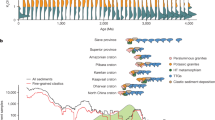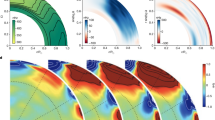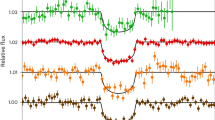Abstract
The mass of the residual hydrogen envelope at the time of the explosion of SN1987A is an important parameter which is currently only weakly constrained by evolutionary models. The evolution of the photospheric radius in the first month is shown to be largely determined by the propagation of a hydrogen recombination wave into the ejecta. Provided that the fireball is expanding homologously and that the outer parts have a power-law density distribution, both the scale density and the power-law index can be determined from the observations. Here we show that the residual hydrogen mass was certainly larger than 2M⨀, and possibly as high as 12M⨀.
This is a preview of subscription content, access via your institution
Access options
Subscribe to this journal
Receive 51 print issues and online access
$199.00 per year
only $3.90 per issue
Buy this article
- Purchase on Springer Link
- Instant access to full article PDF
Prices may be subject to local taxes which are calculated during checkout
Similar content being viewed by others
References
Wood, P. R. & Faulkner, D. J. Proc. astr. Soc. Aust. (in the press).
Arnett, W. D. Astrophys. J. 319, 136 (1987).
Hillebrandt, W., Hoffich, P., Truran, J. W. & Weiss, A. Nature 327, 597–600 (1987).
Maeder, A. in IAU Colloq. 108 (in the press).
Miyaji, S. & Saio, H. in IAU Colloq. 108 (in the press).
Nomoto, K., Shigeyama, T. & Hashimoto, T. in Proc. ESO Workshop on SN1987A (ed. Danziger, J.) (ESO, Garching, in the press).
Woosley, S. E., Pinto, P. A., Martin, P. G. & Wheeler, T. A. Astrophys. J. 318, 664 (1987).
Woosley, S. E., Pinto, P. A. & Ensman, L. Astrophys. J. 324, 466–489 (1988).
Walborn, N. R. in IAU Colloq. 108 (in the press).
Kirshner, R. P. IAU Colloq. 108 (in the press).
Williams, R. E. Astrophys. J. 320, L117 (1987).
Wheeler, J. C,, Harkness, R. P. & Barkat, Z. in IAU Colloq. 108 (in the press).
Dopita, M. A., Achilleos, N., Dawe, J. A., Flynn, C. & Meatheringham, S. J. Proc. astr. Soc. Aust. (in the press).
Catchpole, R. M. et al. Mon. Not. R. astr. Soc. 229, 15–25 (1987).
Menzies, J. W. et al. Mon. Not. R. astr. Soc. 227, 39–49 (1987).
Blanco, V. M. et al. Astrophys. J. 320, 589 (1987).
Hamuy, M., Suntzeff, N. B., Gonzalez, R. & Martin, G. Astrophys. J. (in the press).
Collin-Souffrin, S., Dumont, S., Heidmann, N. & Joly, M. Astr. Astrophys. 83, 190 (1987).
Russell, S. C., Bessell, M. S. & Dopita, M. A. in Star Formation, Proc. NATO ASI (Calgary, in the press).
Branch, D. R. Astrophys. J. (in the press).
Dopita, M. A. IAU Colloq. 108 (in the press).
Author information
Authors and Affiliations
Rights and permissions
About this article
Cite this article
Dopita, M. The recombination wave and the hydrogen envelope mass of supernova 1987A. Nature 331, 506–507 (1988). https://doi.org/10.1038/331506a0
Received:
Accepted:
Issue Date:
DOI: https://doi.org/10.1038/331506a0
This article is cited by
Comments
By submitting a comment you agree to abide by our Terms and Community Guidelines. If you find something abusive or that does not comply with our terms or guidelines please flag it as inappropriate.



